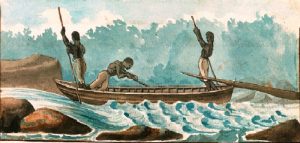
—Marker recalls era when bateaux plied the James River; bateaux’ crews often consisted of free or enslaved African Americans—
—The marker text is reproduced below—
A state historical marker issued by DHR will be dedicated this Saturday that recalls the era when the long, narrow, flat-bottomed boats, known individually as bateau, and operated by crews often consisting of free or enslaved African Americans, carried cargo and passengers between Richmond and points west on the James River and its tributaries. The public ceremony to dedicate and unveil the marker begins at 12 noon, Saturday, October 12, at the sign’s location at 301 Virginia Street, near Richmond’s Riverfront Canal Walk. Speakers during the dedication ceremony will include Delegate Betsy Carr, Richmond Mayor Levar Stoney and Richmond City Council member Cynthia Newbille, Julie V. Langan, DHR director, Sandra Norman of VDOT, and representatives from the offices of Congressman Donald A. McEachin and state Senator Jennifer McClellan. The marker’s sponsors, Arvat McClaine and Harry Watkins, owners of Bateau, a coffee and wine bar on the riverfront canal walk, will unveil the sign. The “James River Bateaumen” marker relays that the 1770s through the mid-1800s is the era when bateaux were most active on the James River system transporting goods between the capital and points west. The era of bateaux on the James waned after 1840, when the James River and Kanawha Canal was completed to Lynchburg. “Crews of three men, often free or enslaved African Americans, performed the difficult and sometimes dangerous work of poling and steering the long, narrow boats,” the marker reads. Bateaux carrying tobacco, grains, iron ore, coal, and other commodities to Richmond helped to make the city an industrial and commercial hub. The “James River Bateaumen” marker was approved for manufacture and installation earlier this year by the Virginia Board of Historic Resources, which has the authority to approve new historical markers. The manufacturing costs of the marker have been covered by the sign’s sponsor, Bateau. Virginia’s historical highway marker program, which began in 1927 with the installation of the first historical markers along U.S. Route 1, is considered the oldest such program in the nation. Currently, there are more than 2,600 official state markers, most maintained by the Virginia Department of Transportation and by local partners in jurisdictions outside of VDOT’s authority such as Richmond. [PLEASE NOTE: DHR markers are erected not to “honor” their subjects but rather to educate and inform the public about a person, place, or event of regional, state, or national importance. In this regard, markers are not memorials.] Text of marker: James River Bateaumen The James River bateau, first used in the 1770s, was the primary means of transporting goods up and down the river between Richmond and points west until 1840, when the James River and Kanawha Canal was completed to Lynchburg. Crews of three men, often free or enslaved African Americans, performed the difficult and sometimes dangerous work of poling and steering the long, narrow boats. Largely unsupervised, bateaumen were entrusted with great responsibilities. They carried tobacco, grains, iron ore, coal, and other commodities to Richmond, helping to make the city a hub for industry and commerce. Traffic typically terminated at the Great Basin, built in 1800 1/5 mile northwest of here.Programs
DHR has secured permanent legal protection for over 700 historic places - including 15,000 acres of battlefield lands
DHR has erected 2,532 highway markers in every county and city across Virginia
DHR has registered more than 3,317 individual resources and 613 historic districts
DHR has engaged over 450 students in 3 highway marker contests
DHR has stimulated more than $4.2 billion dollars in private investments related to historic tax credit incentives, revitalizing communities of all sizes throughout Virginia